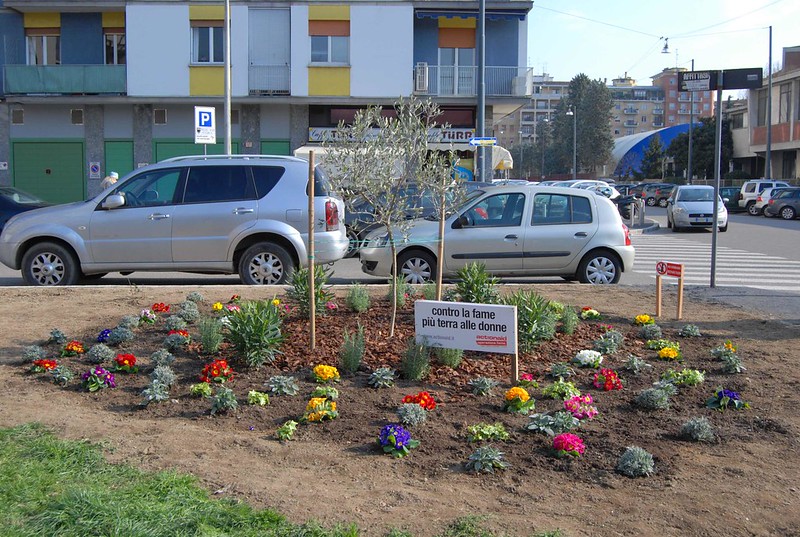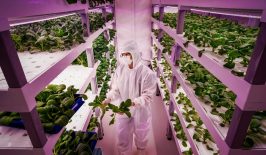Urban gardens are places where healthy food is being grown and people are reconnecting with nature. They also provide spaces for experimenting with new ideas; including what could alternative social models look like, how could intercultural dialogue be encouraged, what do meaningful employment and participation look like in post-growth societies and what is the future of food?
There is no denying that the urban garden trend is booming. “Previously exiled beyond the city boundary, new forms of agriculture are now returning to city centres” with “cities around the world […] rolling out initiatives designed to relocalize part of their food systems”.
It all started in New York: the roots of modern urban gardening
The idea of gardens and agricultural plots in the city is not new. In ancient times as well as the middle ages, farming was an integral part of city life and houses with gardens were a common feature of the cityscape. Garden plots and allotments on the outskirts of towns, as well as in dedicated “garden colonies”, have been around since the 19th century.
However, the origins of the contemporary ‘urban gardening’ movement, which has been growing steadily since the mid-1990s, lie elsewhere: its roots go back to New York’s communal gardens of the 1970s. These community gardens, which still exist today, have transformed inner-city wastelands into blooming oases and provide a range of vegetables for local larders. The concept at the heart of the original movement linked together a wide spectrum of issues – from gardening and nutrition to economic and social models to art and urban design. Juxtaposing conventional (social) models with new practices, the concept was swiftly embraced by communities all across North America.
A number of non-commercial garden concepts, which subsequently spread throughout the world, have their roots in this early community garden movement. They include intercultural gardens, city farms, neighbourhood gardens, school gardens and guerilla gardening.
Cuba has also been a rich source of horticultural practices and ideas in the field of urban agriculture, inspiring for instance the creation of Berlin’s Prinzessinnengarten. After the collapse of communism, the Cuban economy took a nosedive and the country was forced to completely transform its ecological and economic model. State-subsidised urban agriculture was introduced to mitigate the effects of the economic and food crisis. Thanks to the Revolución Verde, which employed simple methods and a healthy dose of ingenuity, more than two thirds of the fruit and vegetables consumed in Havana today are grown within the city limits.
How does it work? A closer look at the different approaches
The focus of modern urban garden models tends to be on beautifying and enriching life in our cities and strengethening community rather than subsistence farming. Flexibility and improvisational skills are both crucial; finding space to plant flowers and vegetables in the midst of dense urban structures requires a creative mindset.
Some urban gardens, for instance Mobile Garden City in London’s Queen Elizabeth Olympic Park, are fully mobile. Vegetables grow in flower pots, sacks or old bathtubs, ensuring that they can be moved anywhere at any time. It’s all about recycling and creativity rather than high-tech and professionalism.
City garden culture is also about creating space to learn together, sharing knowledge and raising awareness. As well as offering people the opportunity of working together in the field, many gardens also offer cultural programmes and workshops.
Community gardens is the generic term for collectively-operated gardens which are mostly located in the city. Commonly run by groups, for instance neighbours, political groups, churches or schools, some of them are also open to the public.
Intercultural gardens are community gardens offering people of different origins the opportunity to grow fruit and vegetables, as well as educational opportunities, international exchange and often a place of peace and refuge.
Neighbourhood gardens, which are located in courtyards of apartment blocks, or in front of or between houses, are run by local resident communities.
City farms are a hybrid concept which usually incorporate farm animals (horses, sheep, goats, chickens etc.) as well as a garden. They appeal mainly to children, offering them the opportunity to ride horses and actively participate in gardening and traditional farm work.
Guerrilla gardening is a subversive approach to urban greening. Using very little equipment and a lot of creativity, guerrilla gardeners see their intervention in the cityscape as a form of political protest. Their activities include planting vegetables in front of the Houses of Parliament in London, growing cannabis in Tübingen’s flower boxes or planting seeds and bulbs in public strips of grass as they pass by. The term itself was inspired by the New York-based artist and activist group Green Guerillas.
Shrinking cities – the green growing in no man’s land
Even though the number of city dwellers is growing worldwide and two thirds of all people will soon be living in cities, many small and medium-sized towns are actually shrinking. As companies relocate and jobs disappear, the tendency is for people to move to large metropolises. Buildings and entire areas are being abandoned, and the shops and businesses move with the people. The free spaces that result offer new opportunities.
Take for example Detroit: In the past, it was the factory that people placed their hopes in, today it’s the garden. The car factories have closed and around one million former residents have left. On the grounds where cars were being built up until the 1990s, carrots are now being harvested. At Earthworks Urban Farm, for instance, volunteers grow organic fruit and vegetables on a surface of 8,000 square metres. No less than 1,234 private and non-profit gardens are now flourishing in Detroit – and their number is on the rise.
Turning abandoned land into farmland in shrinking cities provides employment and food in places where both are in short supply. At the same time, opportunities are created for the development of new urban models, ones in which the boundaries between consumption and production, nature and city, are increasingly blurred.
Urban agriculture in the cities of the south
Urban agriculture is a long-standing tradition in cities like Havana, Caracas and Singapore, with fruit, vegetables and herbs long having been grown in the middle of informal urban settlements. City gardens offer survival strategies for impoverished regions, providing people with food as well as income. There are thousands of community gardens in Buenos Aires, including family gardens, neighbourhood gardens and unemployment schemes. Small agricultural plots are also widespread in the townships of South Africa, with many having been created by the locals on their own initiative, as well as others which are managed by the state, NGOs or private companies such as the Itsoseng Womens Project in Orangefarm.
There are a number of NGOs promoting the exploitation of urban farmland, among them RUAF which supports projects in various countries. City gardens help mitigate the effects of poverty and inadequate food supplies. They also help preserve cultural knowledge and promote the formation of social networks, which in turn fosters the creation of political and social utopias in places where levels of social and economic inequality are high.
Redefining the concept of the city? The significance of urban gardens
The benefits created by city gardens are manifold: From an ecological point of view, they help recycle organic waste, enrich the air with moisture and catch rainwater that would otherwise drain into the sewage system. According to Living Roofs, “… green roofs contribute to the reduction of a number of polluting air particles” and “reduce the heat island effect, which is the main cause of ozone production”. Insects and other ‘city dwellers’ also benefit, as the cultivation of local food contributes to the preservation of variety and biodiversity.
From a socio-political point of view, community gardens bring new life to public spaces and facilitate social exchange. Working the earth side by side, neighbours have the chance to get to know each other better. People from different cultures come together to exchange horticultural knowledge and experience. The flowers and plants a community cultivates can have a vitalising knock-on effect on the community itself. As well as participatory structures enhancing the quality of life in neighbourhoods, children and young people also get the opportunity to learn new practical skills. On top of this, the utilisation of previously unused areas allows citizens to take an active role in shaping the city.
“The act of sowing, harvesting, cooking and preserving for the winter not only brings us into harmony with nature, it also keeps us in touch with the conditions under which we are living. The garden removes us from mere consumer society and places us in a more meaningful and broader context. It affords us a real overview.” (Interview with Christa Müller, author of ‘Urban Gardening’)
Last but not least, urban gardens also act as mini-models for the city of the future, one where food cultivation is woven into the fabric of urban life, where green spaces provide relief from the concrete wilderness, create community, reduce the heat island effect, reduce flooding, and enhance air quality. Shared, social, interactive green spaces should be an integral part of sustainable urban development policies, and city planners should prioritise allocating space for urban farming on a permanent basis – whether it’s on rooftops, walls or wastelands. If we want to secure quality of life for future generations of city dwellers, we need to stop seeing urban areas as disconnected from nature and, instead, as spaces that are embedded in the natural world, and that have the potential to invite it back in.
Translated and last updated by Carola McMahon (2020)









